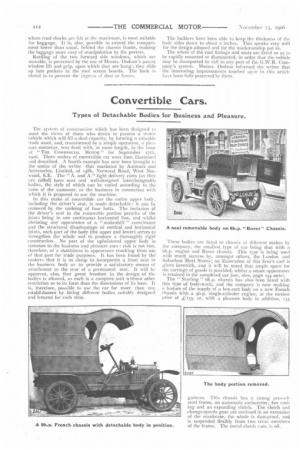A New Type of Motorbus
Page 5

Page 6

If you've noticed an error in this article please click here to report it so we can fix it.
Body.
In the commendable endeavour to increase, to the greatest extent possible, the comfort of the passenger, a number of interesting improvements, and departures from accepted practice in motorbus body building, have been included in the new body constructed for the Great Western Railway Company for a Wolseley-SkIdeley chassis by Christopher Dodson, Limited, of 45, liorseferry Road, Westminster, S.W. For country work over rough roads, and on long journeys during which the traveller may be an occupant of a seat for a considerable space of Lime, a much greater degree of comfort is imperative than that which meets the requirements of the passenger on the short stages covered while going from point to point of the City over asphalt roads, and Ibis fact has been borne in mind by the designers. To begin with an effort has been made to supply seats of such a shape that they will hold the bodies of the passengers with greater comfort than those of the angular construction in vogue at the present time.
The interior seats are arranged to hold 14 persons, disposed as follows : Four on the rear seat; four on the front seat, with their backs to the driver, and six on two intermediate seats, for three passengers each. The gangway is on the near side, and the seats are placed transversely, as will be seen from our illustration : this, naturally, permits the tourist to obtain an excellent view of the country passed through. The roof capacity is 20 passengers : seven double seats are placed on the near side, and six single ones on the off side, and these are interspaced with one another, none being actually abreast, in order that a free gangway may be given when loaded. A roomy entrance is provided, together with steps permitting easy access to the interior, and, at the rear, the staircase is straight and is placed flat against the back of the bus. This construction does not include the usual platform ; the conductor controls the ascent and descent of the passengers, and closes a gate before starling. This arrangement, whilst being admirably suited for country work, would not be possible for metropolitan services, though, by its use, the length of the vehicle is not unduly increased. A very distinctive feature of the body is the disposition of the compartment for luggage, which is, in this case, placed behind the bus interior. The builders are of opinion that, the portion of the vehicle lying between the front and back axles being the most comfortable to travel upon on bad roads, this position, overhanging the rear axle where road shocks are felt at the maximum, is most suitable for baggage. It is, also, possible to extend the compartment lower than usual, behind the chassis frame, making the luggage more easy of manipulation by the porters. Rattling of the two forward side windows, which are movable, is prevented by the use of Messrs. Dodson's patent window lift and grip, upon which they are hung ; they slide up into pockets in the roof screen boards. The back is closed in to prevent the ingress of dust or fumes.
The builders have been able to keep the thickness of the body sides down to about 2 inches. This speaks very well for the design adopted and for the workmanship put in.
The whole of the roof fittings and seats are fitted so as to be rapidly mounted or dismounted, in order that the vehicle may be transported by rail to any part of the C.W.R. Company's system. Messrs. Dodson informed the writer that the interesting improvements touched upan in this article have been fully protected by them.


























